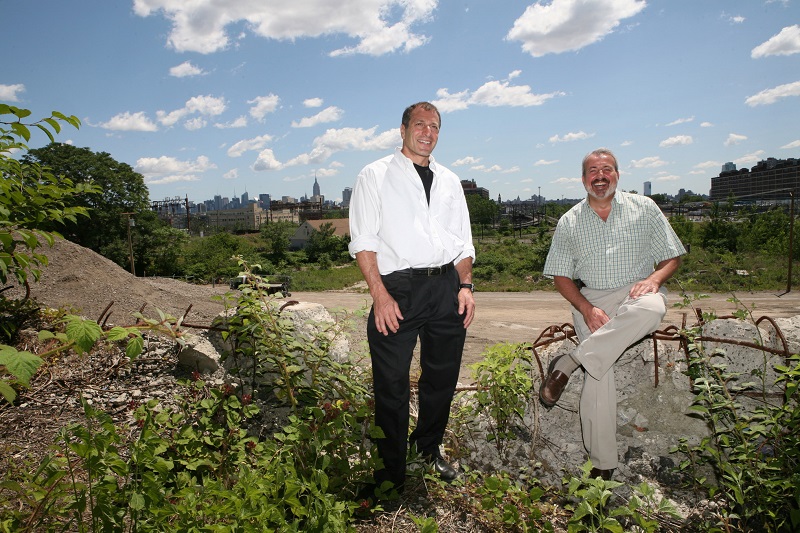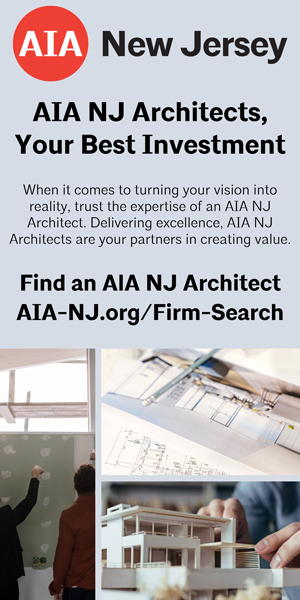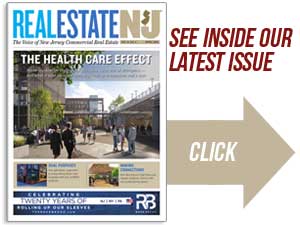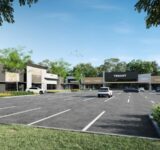George Vallone, co-founder of the Hoboken Brownstone Company, appears at the construction site for phases two and three of The Enclave, a luxury residential development in Jersey City. — Photo by Aaron Houston for Real Estate NJ
(Editor’s note: This story appeared in our March issue and was based on an interview from earlier in the year, prior to the COVID-19 outbreak and the halt of non-essential construction in New Jersey.)
By Joshua Burd
With a name like the Hoboken Brownstone Company, there’s no forgetting the origins of the firm founded by George Vallone and Daniel Gans. But the partners have come a long way from 1980, when they first acquired, gutted and rehabilitated a four-story rowhouse in the city.
These days, they are reaping the benefits of a decision to pivot to a neighboring municipality. The firm and two joint venture partners recently marked the opening of a six-story, 260-unit luxury apartment building in a redeveloping section of Jersey City, which saw overwhelming demand and has yielded two other phases that are now under construction.
Gans and Vallone are undoubtedly bullish on New Jersey’s second-largest city.
“The market is super strong in Jersey City and it’s all a function of the job growth in Manhattan,” Vallone said, pointing to the massive Hudson Yards project and the ongoing World Trade Center redevelopment. “We’ve got two mega projects right now creating around 150,000 new jobs that are feeding the Jersey City housing market.”
With those fundamentals in mind, Hoboken Brownstone now has a development and construction pipeline in Jersey City of more than 2,000 units. The 40-year-old firm has lined up those projects with a tried and true formula: acquiring well-located sites that required demolition and some form of environmental cleanup, working with community groups to pave the way for entitlement changes and then creating development partnerships to bring the buildings to fruition.
To that end, the company garnered acclaim within real estate and environmental circles for the project known as Maxwell Place, its redevelopment of the former Maxwell House Coffee property in uptown Hoboken. With Toll Bros. and Pinnacle Downtown now at the helm, the project has yielded 755 residential units and a mix of retail space over the last 15 years, with its fourth and final phase now rising at the 24-acre former industrial site.

Hoboken Brownstone, or HB Co., sold its interest in the project in 2005. That same year, the company made its entrance to Jersey City when it agreed to buy the site of the former Van Leer Chocolate Factory on Hoboken Avenue, just north of the Holland Tunnel approach, in what was then an aging industrial neighborhood. Gans and Vallone would spend parts of the next decade — which included the Great Recession — remediating and entitling the property before partnering with BNE Real Estate Group and McKinney Properties to build the project.
Jersey City’s luxury apartment market was surging by the time the joint venture completed the first phase in spring 2019, delivering a 260-unit complex at 675 Monmouth St. Known as The Enclave, the community leased up in less than six months, paving the way for the development team to break ground on the site’s remaining two phases.
The second and third buildings, which will have 137 units and 240 units, respectively, are slated to be complete by the fourth quarter of this year and the second quarter of 2021. Like the first phase, the buildings will benefit from a host of amenities and the nearby Hoboken PATH station, which is less than a mile away and accessible via The Enclave’s free shuttle service.
“The dynamics are great and they’re holding strong because of the job creation in Manhattan,” Vallone said, noting that the city now offers a sizable discount from Brooklyn. That was not the case a decade earlier, he said, when Jersey City and Brooklyn were seen as comparable in price.
The Enclave is part of HB Co.’s growing portfolio in the surrounding neighborhood. The firm and a partner, Bill Ackman, control three city blocks immediately to the east that could house another 1,200 units. The developer is under contract to sell one of those blocks — which is bounded by Coles Street, Jersey Avenue, 17th Street and 16th Street — to a New York-based developer that would build out roughly 670 units on the site.

The remaining two blocks, which are on the other side of Coles Street, are approved for another 511 units across three 12-story towers, Vallone said. HBC has donated the front half of the site to Jersey City for what will become the 1.5-acre Coles Street Park between 16th and 18th streets. Manhattan Building Co., which has delivered nearly 800 apartments along Coles Street since 2013 and has another 350 under construction, is now building the park as part of a community benefit agreement with the Jersey City Redevelopment Authority.
Meantime, HB Co. has partnered with The NRP Group of Cleveland to develop a 131-unit project at 39 New York Ave. The project, which is north of the Van Leer redevelopment site, is now under construction and slated for delivery in the second quarter of 2021.
Vallone said his firm hopes to add more than 1,000 additional units to its pipeline with sites that are not yet under its control, but HB Co. is also developing outside Jersey City. In Bayonne, the company is partnering with Cypress Equity Investments for a 354-unit project at the intersection of 22nd Street and Route 440, in a location that is in a federal Opportunity Zone and is less than a block from Hudson-Bergen Light-Rail service.

In New York State’s Capital District, the city of Troy has designated HBC as its developer for a mixed-use project in the up-and coming Monument Square neighborhood, which sits along the Hudson River about 10 miles north of Albany. Spearheading that project is Sumeet Gupta, a former intern who joined HB Co. full-time in 2018. Vallone credits Gupta, who grew up in the Capital District, with introducing him and Gans to the opportunity in Monument Square. He also noted that the development could pave the way for additional work in the city, as the firm is now talking to large property owners about other projects.
“He is our succession plan,” Vallone said of Gupta.
Until then, the firm will have more than enough to keep it busy as it works through its multifamily pipeline. With his eye on the market, Vallone believes Jersey City will attract new for-sale condominium projects to cater to millennials who are maturing, secure in their jobs and forming households. But he also remains bullish on the long-term prospects for apartment developers.
“I think the rental market is going to stay as strong as ever, just because the next generation behind the millennials is coming in and they’re going to have the same demographics as the millennials did,” he said. “They’re going to want to rent and they’re going to want to stay in a more liquid, more mobile lifestyle, which renting gives you.”
A blueprint for green infrastructure

Take a tour of The Enclave in Jersey City and you’ll see a collection of planters, rain gardens and a host of other green spaces that only serve to enhance the luxury apartment community. But as George Vallone will tell you, those features are about more than just aesthetics. Rather, they are part of the complex’s collection of so-called green infrastructure, a modern system that aims to replace traditional, structural forms of storm water management.
“Green infrastructure has to do mostly with storm water management and it has to do with recreating the way nature does it, which is basically infiltration, allowing plants of all different sizes — trees down to grass — to do what nature does really well, which is absorb storm water,” Vallone said.
It’s an approach that is near and dear to Vallone, a longtime proponent of brownfields redevelopment and sustainable urban design. In 2016, during his term as the New Jersey Builders Association’s president, Vallone co-chaired a task force with New Jersey Future’s Peter Kasabach to create what is now the New Jersey Developers’ Guide to Green Infrastructure. Soon thereafter, the state Department of Environmental Protection adopted the guide as a blueprint for its own regulations and has now made green infrastructure mandatory for any development projects beginning this year.
According to Vallone, the guidelines have brought much-needed clarity to the state’s requirements for storm water management. Earlier rules called for developers to include nonstructural storm water management systems “to the maximum extent practical,” which was vague and provided ways for developers to fall back on things such as larger under-building detention basins.
The same task force is now working on an update to the guide with more examples and more how to details, including cost-benefit calculators.
“Now there’s no more subjectivity,” Vallone said. “There’s no more use of the subjective, ‘maximum extent practical’ standard for designing storm water management systems. It’s an objective standard now that essentially says, ‘You do the following things and show that you’re going to control your storm water by using these approved GI techniques, you get your permit.’ So it’s really a wonderful result from the whole thing.”










